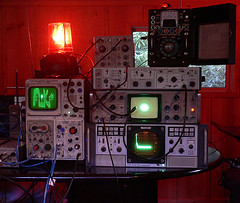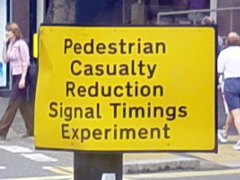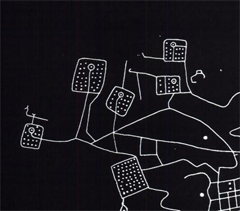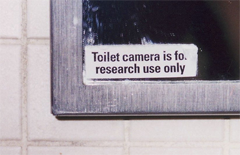






SI 755 / COMM 840.003 -- Fall 2015
Prof. Sandvig, University of Michigan
http://755.niftyc.org/
Announcements
- Don't forget! We agreed to answer the weekly question one hour before class begins.
About the Class
Instructor
Prof. Christian Sandvig
csandvig@umich.edu
734/763-0861
http://www.niftyc.org/
Office: 5385 North Quad
My mailbox is in the 3rd floor School of Information mailbox area, in the 3rd floor kitchen (3351 North Quad)
Office Hours: 3:00-4:00 p.m. Wednesdays and by appointment
Course Description
Any traditional research method was once unorthodox. While many are prone to think about methods as boring tools (or even as a necessary but unpleasant step on the road to results), every boring method was once daring and controversial. This seminar will cover challenging developments in both qualitative and quantitative research methods, including perspectives from the humanities, social sciences, art, design, and engineering. It will address the question of how new research methods are invented, applied, transferred between problems and disciplines, and formalized. The overall focus of the course will be research design, rather than learning the procedures of a single method. In addition, we will spend some time trying to think creatively about possible new methods and research designs. Readings are split between "classics" and recent innovations. In discussion of recent methodological trends, particular attention will be paid to Internet / digital / new media research, algorithm studies, new digital sources of data ("big data" or "computational social science"), spatial / geographic methods, visualization as a research method, activism in/as research methods, and unobtrusive methods. The primary goal of the seminar is to encourage people who want to find things out -- whether using new or old methods -- to see their research method as a creative act.
Learning Objectives
- Answer challenges about your chosen research method with sophistication that far exceeds statements of procedure
- Select your research methods with a keen eye for the breadth of what is now possible
- Write a description of your research method that demonstrates mastery of the philosophical underpinnings of your search for knowledge
- Relate exciting new developments in method to specific pivotal moments in the history of the research enterprise
- Design, introduce, and justify new research methods if necessary
- Take a position on the methodological controversies of your sub-field that is informed and nuanced
Course Credit
- Students from any program are welcome (not just SI or COMM).
- This course is intended for doctoral students. Other graduate students may enroll by instructor permission if there is a good reason to do so.
- Some familiarity with a research method from any research tradition is required; completing most methods courses satisfies this requirement. Co-enrollment in a methods course (i.e. you are enrolled right now) also satisfies this requirement.
Class Requirements
Students will be responsible for a seminar paper proposal and a research paper of about 25 pages. In addition, there will be short weekly assignments or "questions" due at the beginning of each class meeting when reading is assigned. These will be read and discussed in class but not graded. All assignments will be turned in electronically. No late work! No incompletes!
The weekly questions will probably follow this pattern:
4 short responses to questions about methods
4 research designs
1 proposal for a new measure or statistic
2 ideas for new visualizations
1 item of curricular material about methods
Required Books
There are FIVE required books. Other readings will be distributed electronically. You can buy the required books anywhere you'd like. For example, if you buy them new from amazon.com they can be returned for a full refund within 30 days, and if you sign up for "Amazon Student" two-day shipping is free. Most of these books are also widely available as discounted used books, as textbook rentals, and at the library.
A quick word about buying the books: As befits the topic of the class some of them are unorthodox. A librarian and fan of the Lesy book commented, "I can't believe this is an assigned reading for a course!" I know the Webb book is not cheap and the Lesy book is strange but I think you will find them worthwhile.
- Unobtrusive Measures
by Eugene J. Webb, Donald T. Campbell, Richard D. Schwartz, Lee Sechrest
Sage, 1999
(revised edition)
[buy from amazon.com] [buy from alibris] - Envisioning Information
by Edward Tufte
Graphics Press, 2005
[buy from amazon.com] [buy from alibris] (98+ used copies are available on alibris!) - Wisconsin Death Trip
by Michael Lesy
University of New Mexico Press, 2000
(new edition)
[buy from amazon.com] [buy from alibris] (94+ used copies are available on alibris!) - Digital Methods
by Richard Rogers
MIT Press, 2013
[buy from amazon.com] [buy from alibris] (30+ used copies available on alibris -- be sure to check for used hardcover copies) - Digital Research Confidential: The Secrets of Studying Behavior Online
by Eszter Hargittai and Christian Sandvig (eds.)
MIT Press, 2015
This book is due any day but has not yet been released. PDF galleys will be distributed by the instructor.
Other Readings
Additional readings are available online. These are either free on the Web or use password-protected links to PDFs. These password-protected links lead to the reading in Canvas (directly from this page). You do not need to use Canvas to access these readings -- it is easiest to navigate to them by clicking on the links on this page.
Recommended Books
These books are recommended in the sense that every doctoral student working in the social sciences and humanities should own them already. If you don't own them, you should buy them! They are highly recommended.
- Howard S. Becker & Pamela Richards. (2007). Writing for Social Scientists: How to Start and Finish Your Thesis, Book, or Article. Chicago: University of Chicago Press. (any edition is fine.) [Note that although the phrase "social scientist" is in the title of the book, this book is equally relevant to researchers from the humanities who don't identify with that phrase.]
- William Strunk, Jr. & E. B. White. (2000). The Elements of Style. New York: Longman. (Any edition is fine except for the 1920 or 2011 "Original Edition" that does not include E. B. White. Be sure it has E. B. White. If it has Kalman as a co-author too, I think that is OK -- this just means it is the illustrated edition.)
Schedule
These dates and readings will be adjusted to reflect a student interest survey and our progress (or lack of it). This means that you should check the class Web site regularly for updates.
Beware: Note that links on this page to readings are often large PDF files.
Part I: An Overview of Orthodoxy and Research Methods
9 Sep (Wed): Introduction
- Please carefully read the syllabus.
16 Sep (Wed): NO CLASS MEETING
- This meeting time will be made up with other activities as discussed in class. Feel free to start next week's readings early.
23 Sep (Wed): The Fundamentals: Methods, Instruments, and Orthodoxy
- Post your answer to the weekly question to the Canvas forum before class begins.
- Sandvig, C. & Hargittai, E. (forthcoming). How to Think about Digital Research. In: E. Hargittai & C. Sandvig (eds.) Digital Research Confidential: The Secrets of Studying Behavior Online (read ch. 1). Cambridge: MIT Press. (on Canvas)
- Feyerabend, Paul. (1975). Against Method: Outline of an Anarchistic Theory of Knowledge. Humanities Press. (on Canvas)
- Popper, Karl. (1963) Conjectures and Refutations, London: Routledge and Keagan Paul. (read only pp. 33-39, Science as Falsification) (on Canvas)
- Pajares, Frank. (n.d.) The Structure of Scientific Revolutions by Thomas S. Kuhn: A Synopsis. The Philosopher's Magazine. (on Canvas)
- Bird, Alexander. (2004). Thomas Kuhn. Stanford Encyclopedia of Philosophy. Stanford, California: Metaphysics Research Laboratory. (Web reading: read the section "Kuhn and Social Science") http://plato.stanford.edu/entries/thomas-kuhn/#6.3
- Forscher, Bernard K. (1963). Chaos in the Brickyard. Science 142(3590): 339. (on Canvas)
- Ozaktas, Haldun M. (2005). The Optimal Number of Friends in the Information Age. Journal of Irreproducible Results 49(4): 32. [Skim only! This article was intended by the author as a joke!] (on Canvas)
- Optional:
- de Solla Price, Derek J. (1986). Little Science, Big Science... and Beyond. New York: Columbia University Press. (read the chapter: "Of Sealing Wax and String") (on Canvas)
Part II: Case Studies of Unorthodox Research Methods
30 Sep (Wed): Unusual Archives, Database Subtraction, Visual Argument
(includes: The Controversial Case of Michael Lesy's dissertation)
- Post your answer to the weekly question to the Canvas forum before class begins.
- Read Wisconsin Death Trip. (all of it).
- Paglen, Trevor. (2007). Unmarked Planes and Hidden Geographies. Vectors: Journal of Culture and Technology in a Dynamic Vernacular 2(2). Read: Editor's Introduction, browse the interactive project itself (including planes, bases, movements, flight procedures), Author's Statement, Designer's Statement, Peer Response.
- Ankerson, Megan S. (forthcoming). Read/Write the Digital Archive: Strategies for Historical Web Research. In: E. Hargittai & C. Sandvig (eds.) Digital Research Confidential: The Secrets of Studying Behavior Online (ch. 2, pp. TBD). Cambridge: MIT Press. (on Canvas)
- Zongker, Doug. (2006). Chicken Chicken Chicken: Chicken Chicken. Annals of Improbable Research 12(5): 16-21. (on Canvas) (Yes, it's a joke.)
- Optional: See also the conference presentation (YouTube).
- Optional / also discussed in class:
- Paglen, Trevor. (2008). I Could Tell You But Then You Would Have to be Destroyed By Me. New York: Melville House.
- You can browse The Charles Van Schaick Archive of the Wisconsin Historical Society (the source material for Lesy, above): http://www.flickr.com/photos/whsimages/sets/72157602476458793/
- An Interview with Michael Lesy -- http://www.identitytheory.com/michael-lesy/
- Berger, John & Mohr, Jean. (1997). A Fortunate Man: The Story of a Country Doctor. New York: Vintage.
- Berger, John & Mohr, Jean. (2010). A Seventh Man: A Book of Images and Words about the Experience of Migrant Workers in Europe (new ed.) New York: Verso.
7 Oct (Wed): Social Justice, Activism and Method
(includes: The Case of Eric Michaels)
- Post your answer to the weekly question to the Canvas forum one hour before class begins.
- Michaels, Eric. (1994). Bad Aboriginal Art: Tradition, Media, and Technological Horizons. Minneapolis: Minnesota University Press. (excerpts:)
- Langton, M. "Introduction" (1994)
- Hebdige, D. "Foreward" (excerpts: pp. ii-xxi, xxiii-xxv) (1994)
- Michaels, E. "For a Cultural Future: Francis Jupurrurla Makes TV at Yuendumu" (1986)
- Michaels, Eric. (1990). Unbecoming. Durham: Duke University Press. (various excerpts as marked) (Note that this is Michaels's AIDS diary.)
- Rowse, T. (1990). Enlisting the Warlpiri. Continuum: The Australian Journal of Media & Culture 3(2).
- Hodge, R. (1990). Aboriginal Truth and White Media: Eric Michaels meets the Spirit of Aboriginalism. Continuum: The Australian Journal of Media & Culture 3(2).
- Hinkson, M. (2002). New Media Projects at Yuendumu: Inter-cultural engagement and self-determination in an era of accelerated globalization. Continuum: Journal of Media & Cultural Studies 16(2): 201-220.
- Skim the editorial information for the Journal of Universal Rejection.
- Optional / also discussed in class:
- Michaels, Eric. (1982). TV Tribes. Unpublished Doctoral Dissertation. University of Texas, Austin. Austin, TX.
- Deger, Jennifer. (2006). Shimmering Screens: Making Media in an Aboriginal Community. Minneapolis: University of Minnesota Press.
- Srinivasan, R. (2012). Rethinking Digital Cultures and Divides: The Case for Reflective Media. The Information Society 28: 24-36.
14 Oct (Wed): Auditing, Reverse Engineering, and Correspondence Studies
- Post your answer to the weekly question to the Canvas forum before class begins.
- Barocas, S., Hood, S., & Ziewitz, M. (2013). Governing Algorithms: A Provocation Piece. Paper presented to the conference "Governing Algorithms", New York University Law School, New York, NY.
- Gillespie, T. (2012). Can an Algorithm Be Wrong? limn 2: http://limn.it/can-an-algorithm-be-wrong/.
- Field Experiments (p. 103-108), in: National Research Council Panel on Measuring Racial Discrimination, The. (2004). Measuring Racial Discrimination. Washington, DC: National Academies Press. (This is a free PDF download -- read pp. 103-108.)
- Sweeney, L. (2013). Discrimination in Online Ad Delivery ACM Queue 11(3): 1-19.
- Hannak, A., Soeller, G., Lazer, D., Mislove, A., Wilson, C. (2014). Measuring Price Discrimination and Steering on E-commerce Web Sites. ACM SIGCOMM/SIGMETRICS Internet Measurement Conference (IMC ’14).
- Mathias Lecuyer, Guillaume Ducoffe, Francis Lan, Andrei Papancea, Theofilos Petsios, Riley Spahn, Augustin Chaintreau, and Roxana Geambasu. (2014). "XRay: Increasing the Web’s Transparency with Differential Correlation." Technical report. Columbia University.
- Ch. 5: "Search as Research: Source Distance and Cross-Spherical Analysis". In: Rogers, R. (2013). Digital Methods. Cambridge, MA: MIT Press.
- LaLoudouanna, Doudou & Tarare, Mambobo B. (2003). Data Set Selection. Journal of Machine Learning Gossip 1: 11-19 http://citeseerx.ist.psu.edu/viewdoc/download;jsessionid=41081C5E8486C751A2B1402EF9A9AE0B?doi=10.1.1.59.8077&rep=rep1&type=pdf (Skim only -- Note that this paper is not real, sort of.)
- Optional / also discussed in class:
- Datta, A., Tschantz, M. C., & Datta, A. (2015). Automated Experiments on Ad Privacy Settings: A Tale of Opacity, Choice, and Discrimination. Proceedings on Privacy Enhancing Technologies 1(1): 92-112.
- The perspective of a real-life housing auditor: This American Life #512: House Rules. Act One: Rental Gymnastics.
- Edelman, B. (2011). Bias in Search Results? Diagnosis and Response. Indian Journal of Law and Technology 7: 16-32.
21 Oct (Wed): Unobtrusive Methods, Crowdsourcing
- Post your answer to the weekly question to the Canvas forum before class begins.
- Read Webb et al. book Ch. 2-5 and Ch. 8-9 (Approximations to Knowledge, Physical Traces: Erosion and Accretion, Archives I: The Running Record, Archives II: The Episodic and Private Record, and Simple Observation, A Statistician on Method, and Cardinal Newman's Epitaph.).
- Roth, Julius A. (1966). Hired Hand Research. American Sociologist 1(4): 190-196. Read only only the preface.
- Shaw, A. (forthcoming). Hired Hands and Dubious Guesses: Adventures in Crowdsourced Data Collection. In: E. Hargittai & C. Sandvig (eds.) Digital Research Confidential: The Secrets of Studying Behavior Online (ch. 7, pp. TBD). Cambridge: MIT Press. (on Canvas)
- Optional / also discussed in class:
- The complete Roth article from this week.
- Ch. 6 ("Contrived Observation") in Webb et al. may also be interesting.
- Confessions of a mental health research interviewer: This American Life #37: The Job That Takes Over Your Life: Act One, The Test
28 Oct (Wed): Interestingness, Publication Bias, The Decline Effect and the Crisis of Confidence in Significance Testing
- Post your answer to the weekly question to the Canvas forum before class begins.
- Davis, Murray S. (1971). That's Interesting! Towards a Phenomenology of Sociology and a Sociology of Phenomenology. Philosophy of Social Science 1: 309-344. (on Canvas)
- Hacking, Ian. (1990). The Taming of Chance. New York: Cambridge University Press. (Read Ch. 1, The Argument [pp. 1-7]). (on Canvas) (This PDF is intentionally truncated.)
- Hacking, Ian. (1990). The Taming of Chance. New York: Cambridge University Press. (Read Outline of Other Chapters). (on Canvas)
- Sterne, Jonathan A. C. & Smith, George Davey. (2001). Sifting the Evidence: What's Wrong with Significance Tests? British Medical Journal 322: 226-231. http://www.ncbi.nlm.nih.gov/pmc/articles/PMC1119478/pdf/226.pdf (assumes some familiarity with statistical methods.)
- Ioannidis, John P. A. (2005). Why Most Published Research Findings Are False. PLoS Medicine 2(8): 696-701. http://www.plosmedicine.org/article/fetchObjectAttachment.action?uri=inf... (assumes familiarity with statistical methods.)
- Open Science Collaboration, The. (2015). Estimating the Reproducibility of Psychological Science. Science 349(6251): 943, aac4716-1 to aac4716-8.
- Optional:
- Jackman, Simon. (2009). Bayesian Analysis for the Social Sciences. Wiley-Blackwell: New York. (Excerpts.) (on Canvas)
- McCloskey, Donald N. (1986). Why Economic Historians Should Stop Relying on Statistical Tests of Significance, and Lead Economists and Historians Into the Promised Land. Newsletter of the Cliometrics Society 2(2). http://www.deirdremccloskey.org/docs/pdf/Article_180.pdf
4 Nov (Wed): Cartography and Geospatial Analysis
- Post your answer to the weekly question to the Canvas forum before class begins.
- Monmonier, Mark. (1996). How to Lie With Maps (2nd. ed.) Chicago: University of Chicago Press. (Read pp. 1-23 and pp. 139-162)
- de Smith, Michael; Goodchild, Michael F.; & Longley, Paul A. (2008). Geospatial Analysis: A Comprehensive Guide to Principles, Techniques, and Software Tools. (2nd ed.) Leicester: Matador Press. (various excerpts.)
- Borges, Jorge Luis & Casares, Adolfo Bioy. (1946/1975). On Exactitude in Science. In: J. L. Borges, A Universal History of Infamy. (Norman Thomas de Giovanni, tr.) London: Penguin.
- Dodge, M. (2005). "The Role of Maps in Virtual Research Methods." In Virtual Methods: Issues in Social Research on the Internet, pp. 113-128. C. Hine (ed.). Oxford, UK: Berg Publishers. http://personalpages.manchester.ac.uk/staff/m.dodge/cv_files/virtual_methods_chapter.pdf
- Strange Maps -- http://bigthink.com/blogs/strange-maps (this is easier to browse randomly than chronologically, please click around through past posts and be sure you skim at least 10 maps)
- Denis Wood and The Narrative Atlas of Boylan Heights (note the famed Jack-o-Lantern Map [scroll down to see it]).
- Optional / also discussed in class:
- Schrage and Staple of TeleGeography and the Circadian geography of communications networks (no online version available that I can find).
- Roland Vilett and over-time "satellite" maps of GZ City (a virtual world)
- The Tactical Technology Collective: Information Activism -- https://informationactivism.org/en
- The Los Angeles Water Cycle by Jane Tsong
- An Atlas of Radical Cartography by Lize Mogel and Alexis Bhagat -- http://www.an-atlas.com/
- W20JW Radio Activity by Decade by Danny Gregory and Paul Sahre
- Wind Map by Fernanda Viégas and Martin Wattenberg
- The People's Atlas by AREA Chicago.
- War Maps: Sarajevo by Ngaire Ackerley; Beirut (larger view) by Ashkal Alwan
11 Nov (Wed): Visualization as Method
- Post your answer to the weekly question to the Canvas forum before class begins.
- Tufte book (all of it.)
- Kosara, Robert. (2008). Visualization Criticism - The Missing Link Between Information Visualization and Art. IEEE Computer Graphics & Applications (CG&A), Visualization Viewpoints, vol. 28, no. 3, pp. 13-15. http://kosara.net/papers/Kosara_IV_2007.pdf
- Drucker, Johanna. (2011) Humanities Approaches to Graphical Display. Digital Humanities Quarterly 5, 1. http://www.digitalhumanities.org/dhq/vol/5/1/000091/000091.html
- Please skim / play with:
- Peoplemovin by Carlo Zapponi http://www.peoplemov.in/
- Emoji Tracker by Matthew Rothenberg http://emojitracker.com/
G+ Ripples by Fernanda Viégas and Martin Wattenberg http://hint.fm/projects/ripples/(Looks like this has been discontinued! --CS)- Feltron Reports by Nicholas Felton http://www.feltron.com/
- Optional / Also discussed in class:
- The Dumpster by Golan Levin
http://artport.whitney.org/commissions/thedumpster/ (Requires an obsolete Java version to run.) - We Feel Fine by Jonathan Harris and Sep Kamvar
http://www.wefeelfine.org/ (Requires an obsolete Java version to run.)
- The Dumpster by Golan Levin
18 Nov (Wed): Methodology and the Nonhuman Turn
- Post your answer to the weekly question to the Canvas forum before class begins.
- Vertesi, J. (2015). Seeing like a Rover. Chicago: University of Chicago Press. (Ch. 6: Visualization, Embodiment, and Social Order). (On canvas.)
- Bogost, I. (2012). Alien Phenomenology: or, What It's Like to Be a Thing. Minneapolis: University of Minnesota Press. (Ch. 3: Metaphorism, and Ch. 4: Carpentry -- N.B.: "OOO" stands for Object-Oriented Ontology -- On canvas.)
- Latour, B. (1996) Aramis, Or: The Love of Technology. (C. Porter, trans.) Cambridge, MA: Harvard University Press. Excerpts. (Excerpts -- OK to skim this! -- On canvas.)
- Kirksey, S. E. (2010). The Emergence of Multispecies Ethnography. Cultural Anthropology 25(4): 545-576. (On canvas.)
- Optional / Also discussed in class:
- Galloway, A. R. (2014). The Cybernetic Hypothesis. differences 25(1): 107-131. (On canvas.)
- Leahu, L. & Sengers, P. (2015). Freaky: Collaborative Enactments of Emotion. CSCW'15 Companion https://feministcscw2015.files.wordpress.com/2015/01/csde104-leahu.pdf
- "Computers Watching Movies" by Ben Grosser https://bengrosser.com/projects/computers-watching-movies/
- Hertzfeldt, D. (2015). "World of Tomorrow" (video recording -- 16 mins.) https://vimeo.com/ondemand/worldoftomorrow
25 Nov (Wed): NO CLASS (Thanksgiving Recess)
2 Dec (Wed): Digital Methods Grab Bag
- Post your answer to the weekly question to the Canvas forum before class begins.
- Read Introduction, then ch. 6 through ch. 9 (the last half) of the Rogers book (Digital Methods):. Cambridge, MA: MIT Press
- Gilbert, E. and Karahalios, K. (forthcoming). Social Software as Social Science In: E. Hargittai & C. Sandvig (eds.) Digital Research Confidential: The Secrets of Studying Behavior Online (ch. 6, pp. TBD). Cambridge: MIT Press. (on Canvas)
- Bruckman, A, Luther, K., and Fiesler, C. (forthcoming). When should we use real names in published accounts of Internet research? In: E. Hargittai & C. Sandvig (eds.) Digital Research Confidential: The Secrets of Studying Behavior Online (ch. 11, pp. TBD). Cambridge: MIT Press. (on Canvas)
9 Dec (Wed): Teaching Research Methods; Conclusion
- IMPORTANT: The class WILL NOT MEET at the usual time and place. It will be re-scheduled as discussed in class and on your e-mail. See your e-mail for details..
- In deference to your seminar paper, no substantial readings are due today. However, please read the short excerpt linked below and answer the weekly question.
- Eison, J. (2002). Teaching Strategies for the Twenty-First Century. In: R. M. Diamond (ed.), Field Guide to Academic Leadership. San Francisco: Jossey-Bass. (read this excerpt)
- Optional but recommended:
- subscribe to Tomorrow's Professor if you have not already done so and you are interested in teaching in the future.
- The Tomorrow's Professor Archive is also interesting to browse.
16 Dec (Wed): NO CLASS (Finals Week)
21 Dec (Mon): Final paper due
Final paper due at 10:30 a.m. 11:59 p.m. (Deadline extended)
This is the scheduled final exam period for this course according to the registrar's office. Submitting the paper will count as the final examination for this seminar; there is no other final examination. Submit your paper via e-mail to the instructor.
(tl;dr)